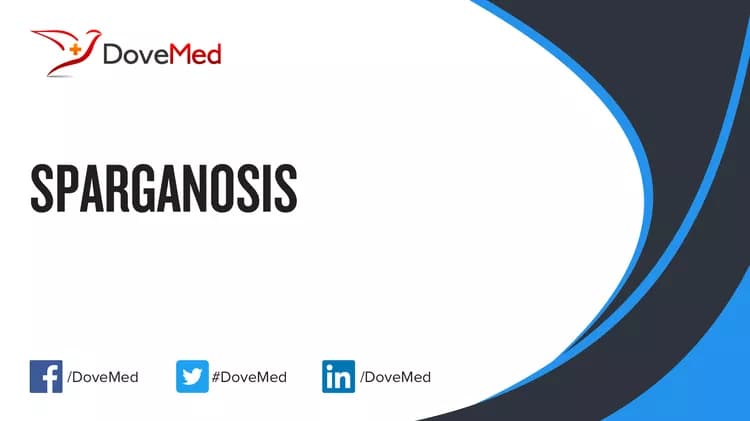What are the other Names for this Condition? (Also known as/Synonyms)
- Spirometosis
What is Sparganosis? (Definition/Background Information)
- Sparganosis is an infection caused by the parasitic flatworm belonging to the genus Spirometra. It is commonly contracted by consumption of unfiltered drinking water and eating raw or undercooked reptiles and fish
- Several species of Spirometra can cause the disease and this varies from one geographical region to another. The infection is seen in many parts of Asia and in some parts of the United States of America
- Following ingestion in humans, the parasite typically migrates from the intestinal tract through the body to a final destination where it resides, or then exits the body
- Migration through the body is usually painless and elicits a minimal inflammatory response especially in the subcutaneous level. Invasion into the central nervous system may involve neurological symptoms such as seizures, weakness, numbness, tingling. Deafness may arise, if invasion occurs in the inner ear canal
- Surgical removal of the parasite from the infection site is normally the most definitive and preferred method to treat and eliminate Sparganosis. With adequate and appropriate treatment, the prognosis is generally good
Who gets Sparganosis? (Age and Sex Distribution)
- Sparganosis is a rare flatworm infection, reported from around the world, but more frequently in areas near water sources and areas of poverty
- Typically, all ages, races, and both genders are susceptible to Sparganosis infection by the Spirometra parasite
- Several species of Spirometra can cause the disease, including:
- Spirometra erinacei, which is common in China and Japan
- Spirometra mansoni, common in Asia
- Spirometra mansonoides, found in southeastern United States
- Spirometra ranarum (exact geographical distribution is unclear)
What are the Risk Factors for Sparganosis? (Predisposing Factors)
Some major risk factors for Sparganosis include the following (in the endemic regions):
- Drinking unpurified or contaminated water
- Eating raw, uncooked or undercooked reptiles, amphibians, fish, and marine animals (especially fresh water species)
It is important to note that having a risk factor does not mean that one will get the condition. A risk factor increases one’s chances of getting a condition compared to an individual without the risk factors. Some risk factors are more important than others.
Also, not having a risk factor does not mean that an individual will not get the condition. It is always important to discuss the effect of risk factors with your health care provider.
What are the Causes of Sparganosis? (Etiology)
Sparganosis is caused by the Spirometra parasite infection in the body. There are many species of Spirometra that cause infection.
- The parasite enters the human host via drinking water contaminated by copepods (types of aquatic crustacean that includes lobsters and crabs) that harbor the procercoid larvae, or by eating undercooked/raw snakes, frogs, fish, reptiles, and amphibians that have been infected
- The larvae penetrate the intestinal tract and migrate through the body to a final destination, but do not mature into adult form in humans. Humans are not a primary host for adult Spirometra, but help serve as an “accidental host”
- Additionally, a different flatworm, called Sparganum proliferum, can also cause Sparganosis
- S. proliferum is distinct, due to its ability to undergo random budding and division that can form multiple larvae or plerocercoids
- Multiple plerocercoids can lead to the formation of multiple lesions at the invasions sites
What are the Signs and Symptoms of Sparganosis?
The signs and symptoms of Sparganosis are dependent on where the parasite localizes in the human body. The following generalized signs and symptoms of Sparganosis may be noted:
- Low grade fever
- Restlessness
- General discomfort
Signs and symptoms when the skin is involved:
- A painless or tender nodule in the subcutaneous layer
- The larva may not grow rapidly, but is able to move and migrate under the skin
Signs and symptoms affecting the nervous system resulting in Cerebral Sparganosis:
- Numbness and tingling sensation
- Weakness
- Dizziness
- Headaches, if the larva enters the brain
- Speech impairment
- Difficulty swallowing
- Memory loss
- Emotional disturbances due to parasitic invasion
- Seizures
Signs and symptoms in breast
- Swelling
- Tenderness of tissue
Signs and symptoms related to the lungs may include:
- Coughing
- Shortness of breath
- Signs and symptoms when the pleural cavity is affected are those that mimic pleuritis (infection of the lining of lungs)
Signs and symptoms affecting the eyes, resulting in ocular Sparganosis:
- Swollen eye
- Redness in the affected eye
- Vision changes
Signs and symptoms related to urinary tract include the formation of a mass on the bladder wall.
The different species of Spirometra are able to invade many parts of the human body, and cause associated symptoms. When this happens, the condition may be termed proliferative Sparganosis.
How is Sparganosis Diagnosed?
Sparganosis is diagnosed on the basis of the following tests and exams:
- A thorough physical and medical history examination
- An assessment of symptoms
- Excision and testing of the infected tissue; testing for the presence of Spirometra eggs or larvae
- Imaging studies that involve X-rays, CT and MRI scans, etc. The imaging results may not be abnormal, except in cases when the larva enter the central nervous system
Many clinical conditions may have similar signs and symptoms. Your healthcare provider may perform additional tests to rule out other clinical conditions to arrive at a definitive diagnosis.
What are the possible Complications of Sparganosis?
The complications of Sparganosis vary and depend on the location of the larvae inside the body.
- Non-proliferative forms most often do not show long-term complications that directly relate to the infection of the parasite, unless the parasite invades the brain and nervous system
- Proliferative forms may result in recurrence of the infection after treatment, if even a few segments of the parasite are left in the body
How is Sparganosis Treated?
The treatment for Sparganosis is dependent on the specific species of infecting flatworm.
- The primary treatment for Sparganosis is to surgically remove the parasite from the area of infection, based on the evaluation by a healthcare provider
- Antiparasitic medications used to treat worm infections are usually not effective against Sparganosis
How is Sparganosis Prevented?
The following measures may be considered towards the prevention of Sparganosis:
- Avoiding consumption of raw reptiles, amphibians, and fish (especially from freshwater and standing water)
- Ensuring that meals containing reptiles, amphibians, or fish are cooked thoroughly prior to being consumed
- Sterilizing potentially contaminated water by filtering or boiling before consumption or use for cooking purposes
- If traveling to an area with reported cases of Sparganosis, familiarizing oneself with the local customs that may include shellfish dishes, medicines, and rituals may be useful
- Washing hands after handling shellfish, dogs and cats (pets) before eating or preparing food
What is the Prognosis of Sparganosis? (Outcomes/Resolutions)
The prognosis of a Spargonosis infection is dependent on the species of Spirometra that has infected the human host.
- Non-proliferative forms (caused by S. ranarum, S. mansonoides, S. mansoni, S. erinacei) have not been reported to be lethal to humans. Removal of the parasite (surgically or via medication) along with treatment of infection results in an optimal outcome in the affected individuals. If the parasite is effectively cleared from the body, no long-term residual effects or complications relating to the parasite are generally reported
- Proliferative forms (caused by S. proliferum) are rarer, but can be lethal in humans. Treatment to excise and surgical remove the parasite including treating any residual effects may have to be undertaken. However, in some cases, battling the frequent and randomly budding/dividing parasite can be difficult to overcome
Additional and Relevant Useful Information for Sparganosis:
- The larvae of Spirometra sp. are frequently referred to by the generic name Sparganum, since the larvae were believed to belong to a separate genus altogether
- The life cycle of Spirometra is described:
- Mature parasite inside dog/cat pass unembryonated eggs out of the body of the host through feces
- Once into the environment (commonly contaminating water), the eggs become embryonated
- The eggs hatch and release what are known as ‘coracidia’ into the environment that are ingested by copepods to become the “first intermediate host”. The coracidia form into the next stage of development known as procercoid
- A “second intermediate host” is established once the copepods are ingested, leading to the infection of the new host by the procercoid established in the primary intermediate host. Once inside the secondary intermediate host, the procercoid larvae mature into plerocercoid larvae
- The adult form is not achieved until a carnivore eats the secondary intermediate host and the plerocercoid larvae establishes itself in the gut of the canine/feline
- Humans act as ‘accidental’ secondary intermediate hosts after they drink the water contaminated with infected copepods, but do not develop the adult form of Spirometra
- Spirometra mansoni is named after Patrick Manson, who discovered the species
Related Articles
Test Your Knowledge
Asked by users
Related Centers
Related Specialties
Related Physicians
Related Procedures
Related Resources
Join DoveHubs
and connect with fellow professionals


0 Comments
Please log in to post a comment.